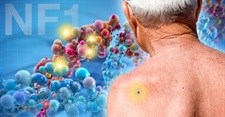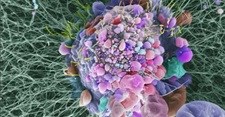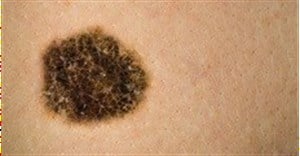
Researchers using microRNA to identify aggressive melanoma
Melanoma is the most aggressive form of skin cancer. Staging, which involves determining the size of the tumour and its extent of spread, is the best predictor of whether a patient will succumb to disease or survive.
However, its predictive ability is relatively inaccurate, particularly for patients with melanomas that have invaded deeply into the skin.
A simple blood test that can be used alongside staging to improve the accuracy of outcome prediction would therefore be an extremely important development.
The project, led by histopathologist Dr Gerald Saldanha and Dr Howard Pringle, both in the University of Leicester Department of Cancer Studies and Molecular Medicine, aims to assess whether the measurement of a certain class of molecule called microRNA can identify patients who are more likely to have aggressive melanoma.
The study involves measuring over 600 microRNAs in the blood of patients with thick melanoma and analysing whether scientists can distinguish one set of melanoma patients in whom the disease has already begun to spread from another set for whom it has not.
More informed planning of treatment
If successful, this study would provide evidence that a blood test based on microRNA analysis could be further developed and used alongside staging.
This would enable more informed planning of treatment for patients who are found to be at greatest risk of poor outcome, while those at low risk could be reassured.
This research represents a new approach to the diagnosis and prognosis of melanoma.
Dr Saldanha, who is also an Honorary Consultant at University Hospitals of Leicester NHS Trust, explained: "I'm a skin pathologist and my job is to look down a microscope to diagnose melanomas and give prognostic information, in other words, the likely outcome for the patients. You tell that from the thickness of the melanoma from the top of the skin to the deepest point, and the deeper it is, the worse the outcome is likely to be.
"How good is that method at predicting outcomes? When the melanoma is very thin, less than 1mm, we're good at predicting. We can tell that 95% of those patients will not have further disease five years after treatment.
"In the case of thicker melanomas we can only predict a 45%-75% five-year survival, which is little better than flicking a coin.
"In looking at the morphology of cells through the microscope we're using methods that were used 150 years ago. It is an integration of everything that's going on at the level of DNA and protein. There's no molecular test that can match that at the moment.
"However, there's a gap in our knowledge regarding the diagnosis of a minority of patients and a gap in the prediction of outcome for quite a significant number of patients. This project should add value to what I do by trying to plug the gap in predicting outcome.
"If you can combine the thickness of the melanoma with the microRNAs and tell that a patient has non-aggressive melanoma, you can reassure the patient and maybe avoid toxic chemotherapy or other drugs. But you've got to be very sure of your tests, of course, if you're going to deny the patient the therapies."
Thin melanomas more easily removed
Thin melanomas are generally easily removable by surgery. Thick melanomas, once they begin to spread, may have a survival rate of as little as 10 months. Gram for gram, Dr Saldanha says melanoma is probably one of the most aggressive cancers. Chemotherapy has limited use, while other therapies based on modulating the immune system have had only a minority of lasting successes.
The new study is a collaboration between Dr Saldanha, who is a histopathologist, clinician and scientist; oncologist Steve Nicholson, who will be helping to take the blood from patients and documenting outcomes and Dr Howard Pringle, who is the molecular scientist of the group.
To eliminate 'false positives' (false leads) Dr Saldanha will also be working with bioinformatics expert at Nottingham Trent University, Graham Ball, hopefully ensuring that only important microRNAs are identified.
The project has received funding from the Leicestershire and Rutland charity Hope Against Cancer, in the form of a Rod Cassady Fellowship, which will enable Dr Saldanha to take on a researcher dedicated to the study.
He said: "This work certainly wouldn't be getting under way without HOPE. This is a new project for us and the funding means I can tackle the research properly and thoroughly from the word go.
"Hopefully, it will pump prime the next stage, too, when we will need to find an independent group of patients to validate the microRNAs we've found. If we can reproduce the findings in a brand new data set that will be very important. This is the first step."
Staggering increase in melanomas
While moles are harmless and very common, melanomas are rarer. Skin contains melanocytes which make pigment and sometimes these can form tumours, which may be aggressive and spread.
Melanomas are, Dr Saldanha says, in the second tier of cancers. Nationwide, doctors see about 10 000 cases a year, compared with 40 000 cases each for prostate, breast, lung and colorectal cancers.
However, the number of melanomas has increased 3-4 fold over the past 20-30 years and by a staggering 60% over the past decade, more than any other cancer, Dr Saldanha says.
"Melanoma is interesting because it's very aggressive and it has this odd pattern of increasing incidence that we haven't got to the bottom of. The biggest increases are in countries where fair-skinned people are exposed to the sun, like Australia, New Zealand and the US, but UV damage and skin cancer isn't a simple story. It isn't as straightforward as lung cancer, for instance, where the more you smoke the more likely you are to get lung cancer.
"It seems to involve sunburn in younger people. It's one of the few solid cancers that is common in young people and is the commonest solid cancer in the15-34 age group. There's some conflict as to whether it's still on the increase or not."

















